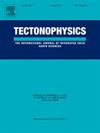希腊爱琴海东部Samos盆地活动断裂及其古地理意义
IF 2.7
3区 地球科学
Q2 GEOCHEMISTRY & GEOPHYSICS
引用次数: 0
摘要
基于地震剖面对萨摩斯岛地区,特别是萨摩斯盆地的地质分析,揭示了以显著变形和地震活动为特征的复杂构造历史。2020年10月的7.0级地震与东西向边缘断层的激活有关,导致了向南倾斜的半地堑的形成。随后发生了3.2到4.5级的余震,这与较小的正断层的激活相对应,主要是在瓦西山脉内。伊卡利亚盆地东部边缘没有明显的变形延伸,这可能是由于萨摩斯盆地断裂(东西向,倾角40°N)与伊卡利亚盆地东部断裂(东西向,倾角65°NW)的方向和倾角不同。伊卡利亚岛东部部分是萨摩斯地区的主要地震危险区,潜在震级为6.5级。托尔顿时代的低角度正断层主要分布在瓦西丘陵东部和萨摩斯东西向边缘断层西段,将基底与上覆沉积物分开。地下室位于东萨摩斯盆地和瓦西丘陵之下,但向西加深至1600多米。整体变形向西明显增加,从东萨摩斯到东伊卡利亚岛50公里的位移是原来的4-5倍(700米vs 3300米)。地层分析表明,在中晚更新世期间,在迈锡尼亚—上新世陆相沉积上存在向东海侵。在萨摩斯岛的南缘可以观察到峡谷和滑坡。早中新世变质基底隆升,中晚中新世陆相沉积盆地形成,以南北向边缘断裂和火山活动为标志。萨摩斯岛地体是在东西向断裂作用下形成的,萨摩斯盆地的沉降发生在早-中更新世。本文章由计算机程序翻译,如有差异,请以英文原文为准。
Active faulting in Samos Basin, Eastern Aegean Sea, Greece and paleogeographic implications
The geological analysis of the Samos Island region, particularly the Samos Basin, based on seismic profiling, has revealed a complex tectonic history marked by significant deformation and seismic activity. The Mw 7.0 earthquake in October 2020 is linked to the activation of the E-W marginal fault, resulting in the formation of a south-tilted half-graben. This was followed by aftershocks ranging from Mw 3.2 to 4.5, which correspond to the activation of smaller normal faults, mainly within the Vathy Hills. No significant deformation extends into the eastern margin of the Ikaria Basin, likely due to the different orientations and dips between the Samos Basin faults (E-W, dipping 40° N) and those in the Eastern Ikaria Basin (NE-SW, dipping 65° NW). The eastern Ikaria segment represents the primary seismic hazard for the Samos area, with a potential magnitude of 6.5. Low-angle normal faults of Tortonian age have been identified primarily in the eastern Vathy Hills and along the western segment of the E-W marginal fault of Samos, separating the basement from the overlying sediments. The basement is found beneath the Eastern Samos Basin and Vathy Hills but deepens to over 1600 m to the west. The overall deformation shows a significant westward increase, with displacements 4–5 times greater (700 m vs. 3300 m) over 50 km from Eastern Samos to Eastern Ikaria. Stratigraphic analysis indicates an eastward sea transgression during the Middle-Late Pleistocene over Messinian-Pliocene continental deposits. Canyons and landslides are observed along the southern margin of Samos. The paleogeographic evolution includes the uplift of the metamorphic basement during the Early Miocene, followed by the formation of continental sedimentary basins in the Middle-Late Miocene, marked by N-S marginal faults and volcanic activity. The Samos Island horst emerged due to E-W faulting, with the subsidence of the Samos Basin occurring during the Early-Middle Pleistocene.
求助全文
通过发布文献求助,成功后即可免费获取论文全文。
去求助
来源期刊

Tectonophysics
地学-地球化学与地球物理
CiteScore
4.90
自引率
6.90%
发文量
300
审稿时长
6 months
期刊介绍:
The prime focus of Tectonophysics will be high-impact original research and reviews in the fields of kinematics, structure, composition, and dynamics of the solid arth at all scales. Tectonophysics particularly encourages submission of papers based on the integration of a multitude of geophysical, geological, geochemical, geodynamic, and geotectonic methods
 求助内容:
求助内容: 应助结果提醒方式:
应助结果提醒方式:


